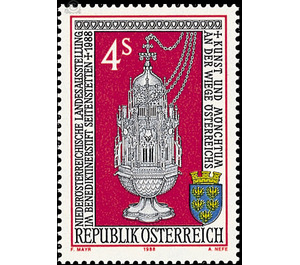Provincial exhibition - Austria / II. Republic of Austria 1988 - 4 Shilling
Theme: Art & Culture
| Country | Austria / II. Republic of Austria |
| Issue Date | 1988 |
| Face Value | 4.00 |
| Color | pink blue |
| Printing Type | combination printing |
| Stamp Type | Commemorative |
| Item Type | Stamp |
| Chronological Issue Number | 1264 |
| Chronological Chapter | OOS-OE2 |
| SID | 637358 |
| In 66 Wishlists | |
The oldest record of the founding of the Benedictine Abbey Seitenstetten in Lower Austria can be found in a Passau Codex from the middle of the 12th century. Thereafter, the Nobles Reginbert von Hagenau and Udalschalk von Stille had founded a choir manor in 1109 at today's cemetery church of St. Veit in Seitenstetten and equipped them with parts of their possessions. The canons active in pastoral care, however, did not live up to the ideas of the donors who were eager for reform, and thus Udalschalk had three years later rebuilt a monastery cell in a suitably suitable location, in which he appointed Benedictine monks from the prestigious Göttweig Abbey. The brand image shows the late Gothic silver censer from the Stift Seitenstetten. Presumably it was commissioned by Abbot Andreas (1501-1521) from a Viennese goldsmith around 1520. It is today the only gothic censer in Lower Austria and the only silver censer of the Middle Ages in Austria.


